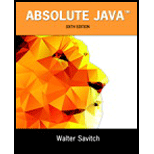
Write a grading
a. There are three quizzes, each graded on the basis of 10 points.
b. There is one midterm exam, graded on the basis of 100 points.
c. There is one final exam, graded on the basis of 100 points.
The final exam counts for 40% of the grade. The midterm counts for 35% of the grade. The three quizzes together count for a total of 25% of the grade. (Do not forget to convert the quiz scores to percentages before they are averaged in.) Any grade of 90 or more is an A, any grade of 80 or more (but less than 90) is a B, any grade of 70 or more (but less than 80) is a C, any grade of 60 or more (but less than 70) is a D, and any grade below 60 is an F. The program should read in the student's scores and output the student's record, which consists of three quiz scores and two exam scores, as well as the student's overall numeric score for the entire course and final letter grade.
Define and use a class for the student record. The class should have instance variables for the quizzes, midterm, final, overall numeric score for the course, and final letter grade. The overall numeric score is a number in the range 0 to 100, which represents the weighted average of the student's work. The class should have methods to compute the overall numeric grade and the final letter grade. These last methods should be void methods that set the appropriate instance variables. Your class should have a reasonable set of accessor and mutator methods, an equals method, and a tostring method, whether or not your program uses them. You may add other methods if you wish.
Want to see the full answer?
Check out a sample textbook solution
Chapter 4 Solutions
Absolute Java (6th Edition)
Additional Engineering Textbook Solutions
Database Concepts (8th Edition)
Starting Out with Programming Logic and Design (5th Edition) (What's New in Computer Science)
SURVEY OF OPERATING SYSTEMS
Starting Out with Java: From Control Structures through Objects (7th Edition) (What's New in Computer Science)
INTERNATIONAL EDITION---Engineering Mechanics: Statics, 14th edition (SI unit)
Mechanics of Materials (10th Edition)
 C++ Programming: From Problem Analysis to Program...Computer ScienceISBN:9781337102087Author:D. S. MalikPublisher:Cengage Learning
C++ Programming: From Problem Analysis to Program...Computer ScienceISBN:9781337102087Author:D. S. MalikPublisher:Cengage Learning EBK JAVA PROGRAMMINGComputer ScienceISBN:9781305480537Author:FARRELLPublisher:CENGAGE LEARNING - CONSIGNMENTProgramming Logic & Design ComprehensiveComputer ScienceISBN:9781337669405Author:FARRELLPublisher:Cengage
EBK JAVA PROGRAMMINGComputer ScienceISBN:9781305480537Author:FARRELLPublisher:CENGAGE LEARNING - CONSIGNMENTProgramming Logic & Design ComprehensiveComputer ScienceISBN:9781337669405Author:FARRELLPublisher:Cengage Systems ArchitectureComputer ScienceISBN:9781305080195Author:Stephen D. BurdPublisher:Cengage Learning
Systems ArchitectureComputer ScienceISBN:9781305080195Author:Stephen D. BurdPublisher:Cengage Learning C++ for Engineers and ScientistsComputer ScienceISBN:9781133187844Author:Bronson, Gary J.Publisher:Course Technology Ptr
C++ for Engineers and ScientistsComputer ScienceISBN:9781133187844Author:Bronson, Gary J.Publisher:Course Technology Ptr Microsoft Visual C#Computer ScienceISBN:9781337102100Author:Joyce, Farrell.Publisher:Cengage Learning,
Microsoft Visual C#Computer ScienceISBN:9781337102100Author:Joyce, Farrell.Publisher:Cengage Learning,





